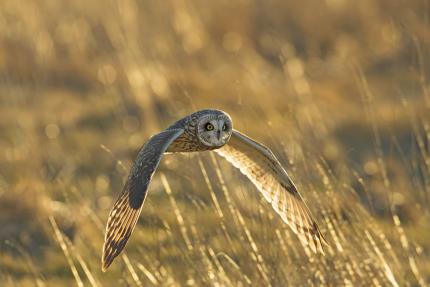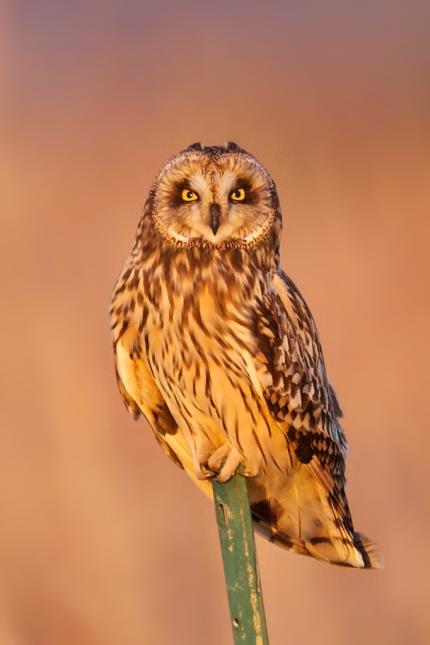The population of short-eared owl is low. The species is thought to be experiencing a range-wide, long-term decline in North America, although the nomadic tendency of the species makes detecting long-term trends difficult. The Washington Department of Fish and Wildlife has designated the owls in western Washington as “Species of Greatest Conservation Need.”
Description and Range
Physical description
Short-eared owls are medium-sized members of the owl family, carnivorous birds of prey. Both sexes can range between 7 to 16 ounces and about 13 to 17 inches long. Wings that span 33 to 41 inches are broad with rounded tips. They are medium brown, with streaked breast and wings, and spotted buff and white on the belly. The ear tufts are short and hard to see, but the pale face and black-rimmed yellow eyes stand out.
Ecology and life history
Short-eared owls breed in landscapes with extensive areas of open land with low vegetation such as fresh and saltwater marshes, dunes, prairies, grassy plains, old fields, shrubsteppe, agricultural lands, and meadows. Short-eared owls tend to congregate and roost communally in the winter, often in sheltered sites near hunting areas.
Short-eared owls are among the owls most frequently seen in daylight, hunting in open country and marshes at dawn and dusk. They eat mostly small mammals such as mice and voles and also hunt for moles, rabbits, rats, and muskrats. Short-eared owls also hunt birds such as shorebirds, songbirds, terns, and gulls.

Male short-eared owls conduct aerial displays that include songs and acrobatics to attract a mate. Female short-eared owls build their nests on the ground by scraping out a shallow, rounded 10-inch bowl that she lines with downy feathers and grasses. Preferred nest sites are dry areas with enough vegetation to provide protection. Females lay between 1 to 11 eggs, which hatch between 21 to 37 days.
One of the more interesting aspects of short-eared owl life history is their tendency toward nomadism (highly variable, non-seasonal movements). In Washington, although there are places where the species breeds nearly every year, it is more common that individual owls move across large regions and settle far from where they nested the previous breeding season. Such movements may be related to changes in populations of their small mammal prey species. These dramatic changes in the distribution and abundance of the owl make it difficult to understand their population status.
Geographic range
Short-eared owls are relatively scarce in Washington. In eastern Washington they are an uncommon winter visitor, migrant, and summer resident in open lowland habitats. In western Washington, they now appear to be scarce or absent in many areas where they used to be, such as in estuaries, prairies, and coastal dunes. There is no population estimate for this species in Washington.
For a map of worldwide distribution and other species' information, check out NatureServe Explorer and the International Union for Conservation of Nature Red List.
Climate vulnerability
Sensitivity to climate change
Low-
Moderate
The short-eared owl has low physiological sensitivity due to its wide geographic distribution throughout North America, South America, Eurasia, and Africa; temperature does not appear to be a limiting factor for this species. Barn owls may be direct competitors in some locations and displace short-eared owl populations. Variation in short-eared owl population size has been attributed to variations in small mammal abundance, thus this species is sensitive to changes in prey availability.
Exposure to climate change
Low
- No specific climate factors identified, although increased temperatures and/or changes in precipitation that affect prey availability will negatively impact this species.
Conservation
Note: WDFW lists and manages the short-eared owl in western Washington as a Species of Greatest Conservation Need.
Our Conservation Efforts
Western Asio flammeus Landscape Study
WDFW is a partner in this eight-state program, which is a three-year monitoring project that is largely dependent on volunteer naturalists to collect data that will allow scientists to better understand the population status, trends, and habitat associations of the species in an area of over 200 million acres in the western United States. In Washington, survey areas for the WAfLS project were all situated in the Columbia Basin. The project was conducted in 2018-2020.
WDFW was involved in this project by helping draft and submit the proposal for funding and serving as survey coordinator for the state of Washington. The survey coordinator recruited volunteers and helped address any questions they had about aspects of the project.
Resources


